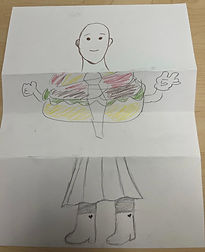BLOG#5: Drawing and Painting as Language
As an early childhood educator, drawing will be a huge part in most of the art activities done with the children in your classroom. Even at home, children would be drawing to pass time, they have an idea and want to illustrate it, or just because they like drawing and colouring. As an educator, it will become a norm in the classroom to see the children drawing, or even painting when the materials are out. And it will be the educator's responsibility to encourage the children’s creativity in drawing and painting, and teach the children of the different ways they can draw and paint to develop their understanding about art, drawing, and painting. Also, as educators, there will be times when children will believe that they “cannot draw.” When that happens it is the educator's responsibility to support the children to realise that it is not true, and that there are many ways to draw and that drawing is about having fun, and that it is not about perfection. Some of the ways educators can help and support children is by starting small and with basic art drawings, helping the children in a step by step process when drawing. Then, once the children get comfortable with drawing, the educators can help the children with more complex drawings and freestyle drawings with the educators giving the topic of the drawing.


Photos by Faten Wehbe 2023


Photos by Ghada Bahru 2023



Photos by Shantelle Zhou 2023




Photos by Rachel Zhang 2023


Photos by Hind Wehbe 2023
There are stages in the making of art, and in the case of drawings and paintings they may start as sketches, basic shapes, then the process of making the final copy of the drawing or the painting. And what was learned when creating these artworks, is that there is an order to drawings and painting, from starting in the background, middleground, then foreground, or from starting with back basic shapes to more complex shapes. According to Fox and Schirrmacher (2014), the element of art Shape is the way of critiquing two dimensional art that has length and width, and that shape reference the outside form of an object, is the frame of an enclosed space, is represented by the outline or the colour or texture of the surrounding area, and that shape is created by connecting lines (p. 127). Some of the qualities and characteristics of Shape are simple and complex, geometrical and non-geometrical, clearly defined and vaguely defined, tall and short, big and large, small and little, open and closed, or symmetrical and asymmetrical, and many more (Fox & Schirrmacher, 2014, p. 127). Throughout the drawings and paintings shown in this page, the element of art Shape has been used, where in some of the artwork illustrate simple shapes such as circles, some shapes and are non-geometrical illustrating a landscape. Moreover, when using shapes and going onto breaking down the process of making art into stages, artists can redo and fix up things in their drawings or paintings to their liking, until the final stage of their drawing or painting to complete their artwork. Stages are also important because of colour mixing, when mixing colours you would want to get the colour you are trying to make using the primary colours and when you are creating your painting in stages you can test out the colour you mixed before going right away and add the colour to your painting. Another thing, when breaking the process of crafting your artwork into stages, you are also breaking down the story or message you are trying to tell others using drawings and paintings. Thus, drawing and painting can be seen as a whole different language to communicate with, because when drawing or painting the artist is able to represent many things through their artwork. Such as the artist's feelings, telling a story using their artwork, or even drawing an image of a subject that the artist saw and wanted to share what they saw through the drawing to others. These representations can be illustrated, using shapes or even colours to convey feelings and images.
Word Count: 660
By: Ghada Bahru



